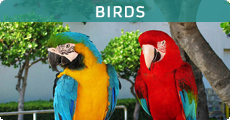Flamingo
Flamingo:
Flamingos are found widely in Asia, Africa, Europe, South America and the Caribbean Sea and the wild flamingos are seen in Florida.  Flamingoes are hardly long-lived birds. They are pinkish white in color with black flight feathers. The pink color has been acquired from their diet. During flight the neck and feet stretch far out behind and before the slender body with flapping wings and a curved beak, which helps to distinguish the flamingo from geese.The species of Flamingo are of six types all of which come from rather harsh inhospitable environments. They are Caribbean Flamingo, Greater Flamingo, Chilean, Lesser Flamingo, Andean and James. Flamingos live in huge groups all year long known as colonies and they do not nest each and every year. The nests are made up of mud and small stones and it is in the shape of a volcano.Although Flamingoes are very social birds, they tend to fight with each other often.They are usually noisy and pecking skirmishes but they never cause any damage. The most disastrous consequences caused by this fighting is scrambled eggs.
Flamingoes are hardly long-lived birds. They are pinkish white in color with black flight feathers. The pink color has been acquired from their diet. During flight the neck and feet stretch far out behind and before the slender body with flapping wings and a curved beak, which helps to distinguish the flamingo from geese.The species of Flamingo are of six types all of which come from rather harsh inhospitable environments. They are Caribbean Flamingo, Greater Flamingo, Chilean, Lesser Flamingo, Andean and James. Flamingos live in huge groups all year long known as colonies and they do not nest each and every year. The nests are made up of mud and small stones and it is in the shape of a volcano.Although Flamingoes are very social birds, they tend to fight with each other often.They are usually noisy and pecking skirmishes but they never cause any damage. The most disastrous consequences caused by this fighting is scrambled eggs.
Diet:
Flamingo has the habit of filter- freed on brine shrimp. They have oddly-shaped beaks which are used to separate mud and silt from the food they eat in upside-down manner. It contains the hairy structures called lamellae and large rough surfaced tongue which is used in the filtering of food items.
The characteristic pink coloring in Flamingo is due to the Beta carotene in their diet. Flamingo produce milk like pigeon milk due to the action of a hormone known as prolactin.This also contains more fat and less protein which is produced in the glands lining the whole upper digestive track. Male and female flamingo nurses their chick and young flamingo feed on this milk which has red and white blood cells for two month until the bills are developed.
Appearance:
Flamingo usually stands on one leg and the reason for this behavior is not known still. A leg of Flamingo is often tucked under the body since some other animals has the ability to have half of its body portion go into a state of sleep, but this has not been proved. It is suggested that tucking of legs is done to keep the legs from getting wet. When it was standing on the water their webbed feet in the mud id used to stir up food from the bottom and the researches has indicated that standing on one leg allows the birds to conserve more body heat.
Young flamingo is grey plumage, but adult range from light pink to bright red because of bacteria and beta carotene obtained from their food they eat. Captive flamingo are a notable exception which may turn a pale pink as they are not fed carotene when compared to the wild.












